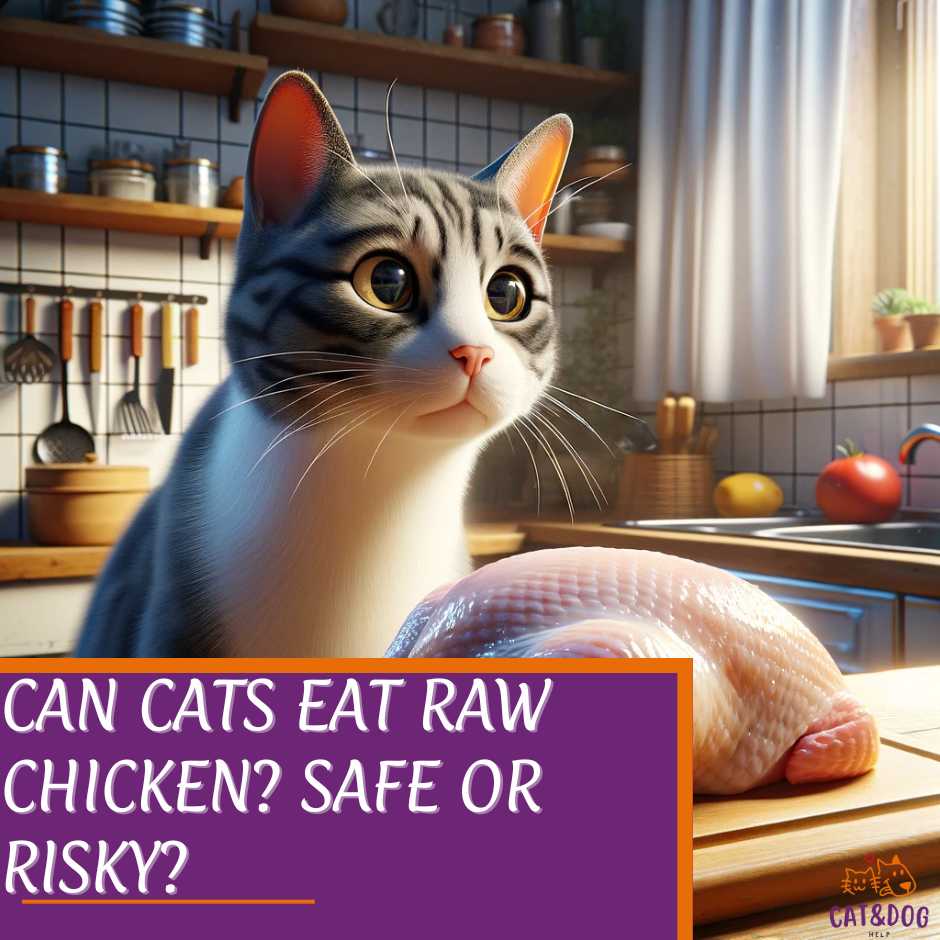Have you ever noticed the growing chatter about cats being fed raw diets?
You might be wondering if it’s okay for your feline friend to have a piece of raw chicken.
After all, you know they’re carnivores, but does that mean raw chicken is beneficial or safe? You’re not alone in this; many cat owners are seeking answers to the same questions.
Supporters of raw diets for cats usually mention that such meal options allow the cat to consume the food felines are biologically prepared to digest.
It’s important to look at both sides of the debate before deciding what is best for your pet. Consult with the vet as well to get specialist advice before making up your mind.
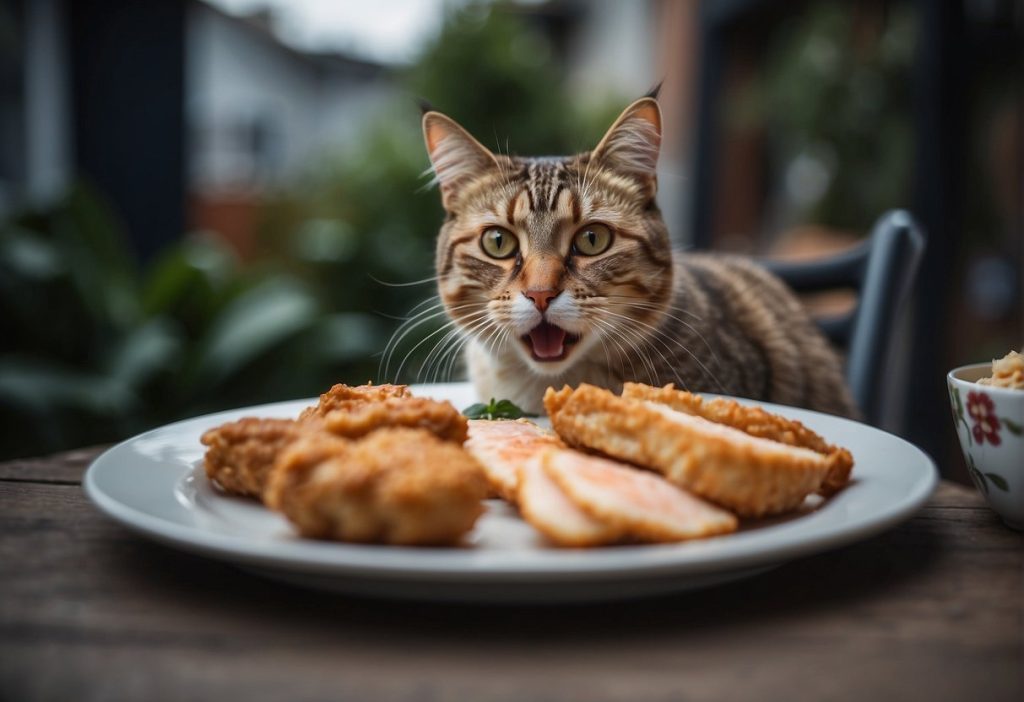
Let’s face it, cats have been hunting and eating their prey in the wild for millennia, yet domestication has changed their eating patterns.
While some argue that a raw diet could reflect a more ‘natural’ meal for our four-legged companions, it’s essential to weigh the potential risks against the benefits.
So, can cats eat raw chicken?
It is crucial to understand the nutritional value of raw chicken and the safety measures necessary for feeding it to your cat.
With benefits and drawbacks on both sides of the argument, it’s no surprise that wonder specialists are yet to find the definitive answer to the question of whether should cats eat raw chicken or indeed any other raw meat.
Speaking with your veterinarian is the best way to keep your cat safe while considering a raw diet or giving them a snack as you cook dinner.
Expect an honest scoop here, backed by evidence and expert insights, without beating around the bush.
By the end of this read, you’ll be equipped to make an informed decision on whether raw chicken deserves a spot in your cat’s food bowl.
Key Takeaways
- Raw chicken can be part of a cat’s diet, but understanding the benefits and risks is vital.
- Feeding raw chicken requires strict safety measures to avoid health issues.
- Expert opinions and nutritional analysis inform sound decisions for a cat’s diet.
Nutritional Analysis of Raw Chicken for Cats
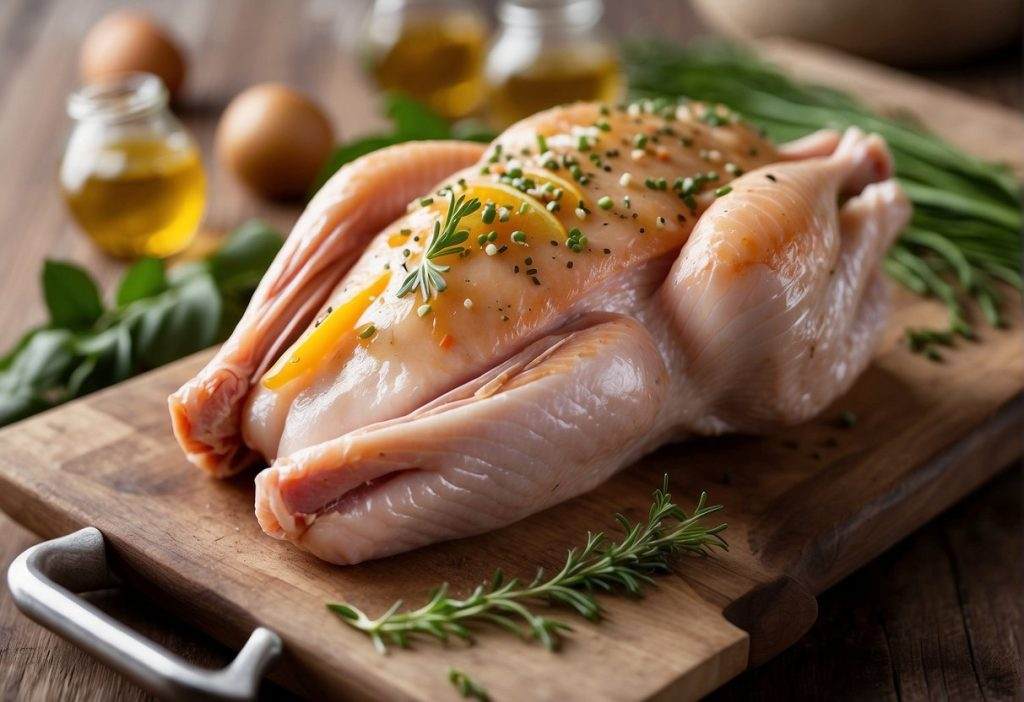
Ever wondered how that piece of raw chicken might fare in your cat’s diet compared to the store-bought munchies? Let’s break it down.
Raw chicken is packed with proteins—essential for your feline’s muscle health—and fats, which provide energy and aid in nutrient absorption. (1)
Don’t forget those micronutrients, like taurine, an amino acid crucial for your cat’s heart and eye health.
Feeding raw chicken to your cat can lead to nutritional deficiencies and diet-related health issues, as the nutrients and vitamins in raw chicken are not as high as those in high-quality cat food. (2)
It is important to note that raw chicken itself does not have a complete nutritional profile, so it should not be fed as the sole food for your cat.
Veterinarian-approved cat food is the best way to provide your cat with the essential nutrients needed for a healthy, balanced diet.
One other important component of chicken is vitamin E, a powerful antioxidant that supports overall feline health.
Here’s a glance at the numbers:
- Protein: Approximately 18-20 grams per 100 grams of raw chicken
- Fat: About 14 grams per 100 grams
Compared to many commercial cat foods, which can range from 25-35% protein and 10-20% fat on dry matter basis, raw chicken can seem similar in protein content.
However, commercial diets are specifically formulated to meet all of your cat’s nutritional needs, including vitamins, minerals, and amino acids.
So, how does this stack up against what a wild cat might snack on? Small rodents and birds are the typical menu items for a cat in the wild, boasting high protein and lots of moisture—a win for hydration!
Research suggests that domestic cats’ nutritional needs aren’t far off from their wild cousins. They all need that protein punch and raw chicken, a staple of a raw food diet, seems like it could fit the bill.
But don’t rush just yet—it doesn’t offer the complete nutrition that commercial diets or a diverse prey menu in the wild would.
Supporters of a raw food diet for cats believe that mimicking a wild cat’s diet—which would be filled with raw meat, bones, and organs—is ideal, as cooking meat can alter the vital nutrients in meat.
Cats are obligate carnivores, meaning they must consume animal products, such as raw chicken, to survive.
They thrive on high-protein diets with substances found in meat, such as fatty acids, taurine, and other essential vitamins. (3)
Remember, your cat’s diet should be balanced, much like our own. So, while a sliver of raw chicken might not be a culinary crime for our furry pals, relying solely on it might leave gaps in their diet.
Raw chicken recipes made at home are less likely to have complete and balanced portions of nutrients, thus increasing the risk of various nutrient deficiencies for your cat.
However, with a good knowledge of what nutrients a cat needs, a more balanced diet is possible, ensuring that your feline friend receives all the necessary portions of nutrients.
Considering cats’ dietary needs, it’s essential to weigh the nutritional benefits of raw chicken against other foods like sausages, to ensure a balanced diet.
Expert Opinions on “Can Cats Eat Raw Chicken?”
Have you ever found yourself wondering about the buzz around raw chicken diets for your feline friends?
Well, you’re not alone! Many veterinarians, particularly those specializing in pet nutrition, have been weighing in on this age-old debate.
Veterinary Insights: Some vets champion a raw meat diet for cats, drawing comparisons with their wild counterparts. However, it’s not all a purr-fest; there’s a heated discussion in the vet world.
While the benefits such as better dental health and a shinier coat get appreciative nods, concerns about health risks like salmonella presence and the potential safety concerns with bacteria and parasites from eating any type of raw meat cannot be ignored.
In 2012, the American Animal Hospital Association, with the endorsement of the Association of American Feline Practitioners, provided a statement against raw food diets for cats. (4)
- Benefits:
- Dental Health: Chewing raw chicken may reduce plaque buildup.
- Coat Condition: Natural fats in raw meat can achieve that Instagram-worthy gloss.
- Risks:
- Bacterial Infections: Raw chicken can harbor salmonella and E. coli, which can lead to serious health issues for both pets and their owners.
- Nutritional Imbalance: An Exclusive raw diet could lead to nutrient deficiencies.
Let’s not gloss over those risks. Veterinary case studies highlight instances of salmonella infection traced back to raw pet diets.
On the flip side, others have reported seeing an improvement in a cat’s physical condition and vitality when switched to raw foods.
While exploring safe and nutritious alternatives to raw chicken, it’s important to also consider the best raw diets for healthy cats, which are carefully balanced to meet all their nutritional needs.
Do you go for that all-natural buzz or play it safe? While it’s tempting to mimic a cat’s natural diet, remember to weigh the experts’ insights.
Consulting a veterinary nutritionist might shine the brightest light on the path for your purr-pal’s gastronomical journey.
Safety Measures for Feeding Raw Chicken to Cats

When you’re considering adding raw chicken to your cat’s diet, it’s like preparing a gourmet meal—safety first! Here’s your game plan to keep those purrs going and the vets at bay:
Safe Preparation and Handling
You wouldn’t use the same cutting board for your veggies and raw meat, right? Cross-contamination is a no-go:
- Clean Surfaces: Always use a sanitized surface and a clean knife exclusively for the chicken.
- Separate Utensils: Dedicate tools for preparing your cat’s raw chicken to avoid mixing with other foods.
- Storage Savvy: Keep raw chicken in the fridge, separate it from other foods, and use it within a couple of days.
Feeling unsure? A quick peep at an online tutorial or video on safe handling could be a big help!
Best Practices to Minimize Health Risks
Think of your feline friend as a VIP—Very Important Pet. Regular vet check-ups are a must to catch any sneaky issues. Keep an eye on your kitty for unusual behavior or symptoms post-chicken:
- Vomiting or Diarrhea: Not the best signs; could mean trouble.
- Lethargy: If Mittens isn’t as bouncy, it’s a red flag.
Considering the digestive risks for cats, it’s crucial to observe your pet closely after introducing raw chicken to their diet, as some may experience gastrointestinal upset or more serious digestive issues.
Remember, every cat is a world of its own. What works for Whiskers might not for Garfield, so monitor closely.
Here’s to happy, healthy, chicken-loving cats!
Alternatives to Feeding Raw Chicken
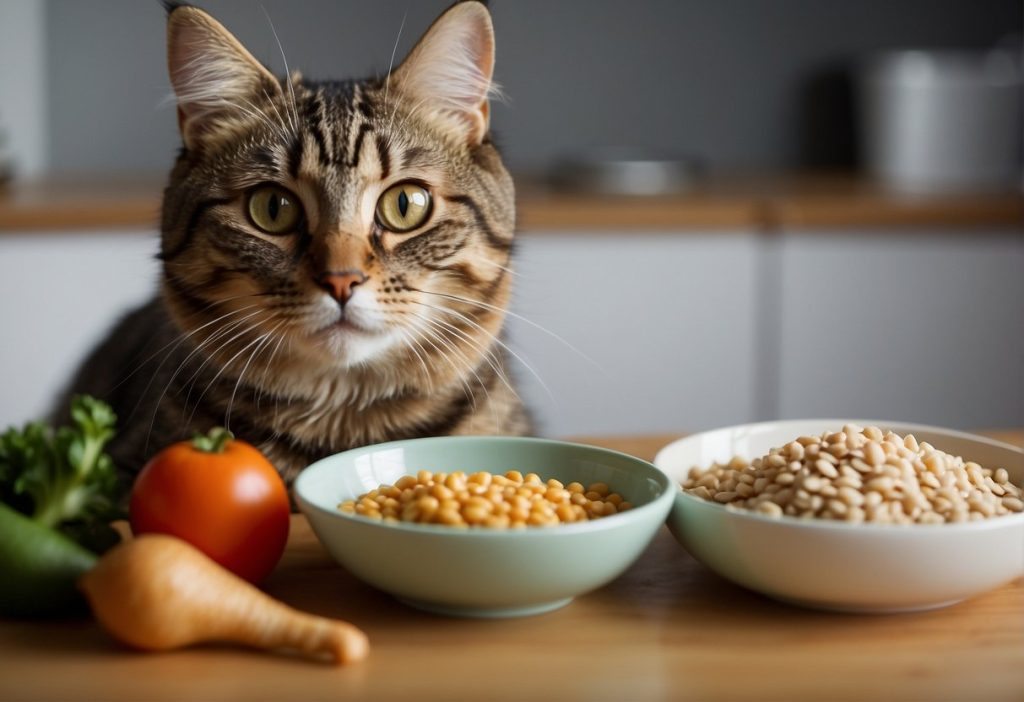
Have you considered non-raw options for your fuzzy companion’s menu? Let’s explore some safe and nutritious alternatives to raw chicken for your feline friend.
Commercial Raw Cat Food Options
Not keen on handling raw food? You can opt for commercially available, reputable cat food based on raw meat that is specifically formulated by pet nutritionists to meet the needs of your pet.
Brands like Stella & Chewy’s and Nature’s Variety offer freeze-dried raw options that mitigate some of the health risks associated with raw meat.
However, remember, these can be pricier than homemade meals and still carry a risk of contamination if not handled properly.
It is important to ensure that these commercial raw diets meet safety standards and are constantly tested to guarantee the well-being of your pet. (5)
Safe Cooking Methods and Other Meats
Ready to don your chef’s hat? Cooking chicken for your cat is a breeze. Simply:
- Remove all bones as they can be a choking hazard or splinter
- Cook thoroughly, ensuring there’s no pink meat or juices
- Avoid seasoning; cats don’t need extra flavors to enjoy their meal!
Additionally, you can serve up some turkey or lean beef as tasty and protein-packed alternatives to chicken. Just ensure these are also cooked plain and properly.
Remember, while venturing into the world of feline cuisine can be exciting, it’s essential to avoid ingredients toxic to cats, such as onions or garlic, grapes, tulips..
Consulting with your vet on portion sizes and dietary needs is always a wise step to keep your cat purring with delight and health.
Addressing Individual Cat Needs
Have you ever considered that your furry friend’s dinner plate might need a little personalization? Just like us, every cat comes with its own set of dietary needs based on factors like age, health, and lifestyle.
Here’s a quick guide to tailoring your cat’s diet to meet their unique requirements.
For the spunky kittens in your life, they’ll need a high-calorie diet to support their rapid growth. Think of them as little athletes who need plenty of fuel to run, jump, and climb!
In contrast, your senior cats often lead a more relaxed lifestyle and may require fewer calories. They might also benefit from diets lower in fat and enhanced with supplements to support joint health.
Now, let’s consider cats with specific health conditions. A fleeting look at a chubby tabby might be cute, but obesity isn’t a joke; these cats might need a leaner diet with carefully monitored portions.
Got a cat with kidney issues? They often thrive on diets low in phosphorus and protein.
Remember, variety is the spice of life! A switch to a raw chicken diet could be just what the vet ordered, or it might be a recipe for tummy troubles. Keep an eye out for changes in their health post-diet changes.
Some cats may show improved coat conditions, while others might not stomach the switch so well, making frequent visits to the litter box.
Here’s a little cheat sheet to help you remember:
| Cat Type | Diet Focus | Example |
| Kittens | High-calorie, high protein | High-energy kibbles |
| Seniors | Low-calorie, joint support | Senior formula, omega-3s |
| Obese | Weight management | Portion-controlled kibbles |
| Kidney | Low phosphorus/protein | The kidney supports wet food |
With a dash of observation and a pinch of patience, you’ll have your cat’s diet purr-infected in no time!
Don’t forget to consult your vet before making any diet overhauls; they’re the experts on your cat’s nine lives after all.
Enhancing User Engagement
Hey, curious cat owner! Ever wondered if a raw chicken feast would suit your feline friend? Let’s make this journey of discovery interactive and fun.
Quiz Time! Test your knowledge about raw diets for cats with this quick quiz:
- Do cats in the wild eat raw meat? Yes or No
- Can raw chicken be a risk for your cat? Definitely or Not a chance
- Is cooking chicken better than serving it raw? Maybe or Never
Let’s Chat Did you know that while wild cats do eat raw meat? it’s a whole different game for our comfy, cozy house cats? Raw diets can be ticklish, with potential health risks.
But hey, no need to let the confusion stick around like a stubborn furball!
- Join Forums: Share stories, ask questions, and get tips from fellow cat lovers in online forums.
- Vet Helplines: Got a question? A quick call to a vet helpline might just be the perfect answer.
- Pet Nutrition Apps: Digital support is a touch away with apps designed to guide you through pet nutrition.
Remember, every cat is unique, so while fluffy from down the street thrives on a certain diet, your Mr. Whiskers may not.
Information is your best friend – and getting it should be as enjoyable as watching your cat chase its tail!
Let’s keep it simple, but let’s not skimp on the fun, right?
Quick Recap
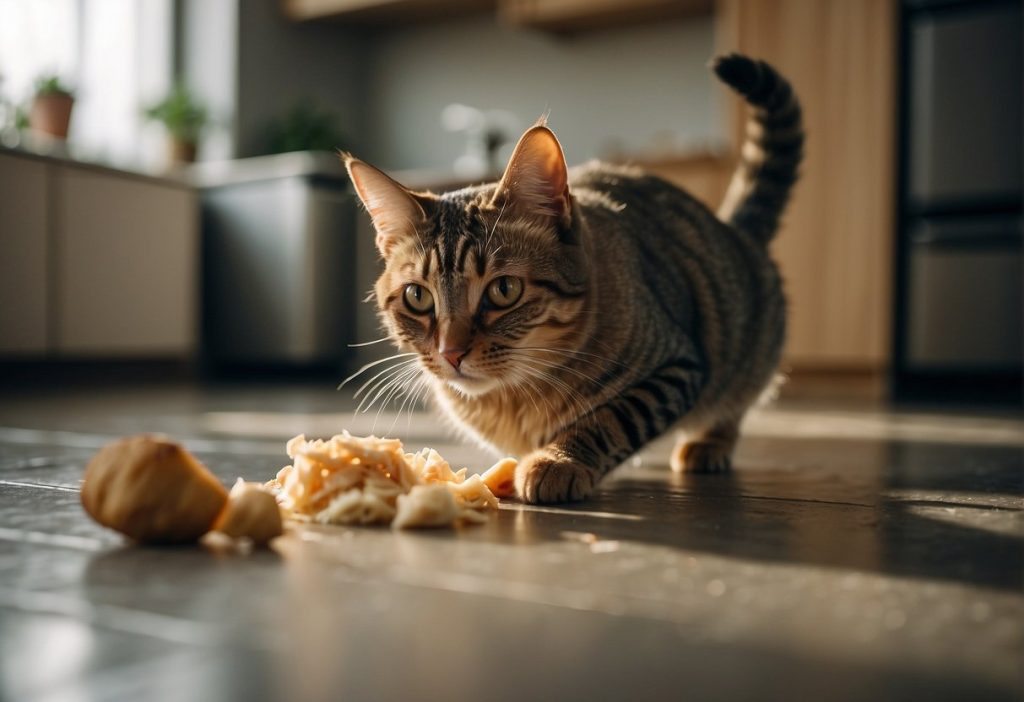
Hey, cat lovers! Wondering if your feline friend can chomp on raw chicken during mealtime? Let’s break it down into bite-sized chunks.
Safety First:
- Raw chicken is not inherently toxic to cats.
- However, it carries health risks such as bacterial infections (salmonella, E. coli).
Veterinarian Input:
- Always ask your vet first. Each cat is unique, and your vet knows what suits yours best.
Pros & Cons:
- Pros: High in protein, a natural part of a cat’s ancestral diet.
- Cons: Risk of bacteria, potential for choking on bones, nutritional imbalance without proper planning.
Precautions:
- Serving: If given the green light, handle, and store raw chicken carefully to avoid contamination.
- Bones: Raw bones can be a choking hazard or cause internal harm.
Here’s a glance:
| Do’s | Don’ts |
| Consult with your vet | Ignore the risk of bacteria |
| Serve in moderation | Feed raw chicken as the sole diet component |
| Know your cat’s health | Forget about proper food handling and storage |
Remember, you’re the gatekeeper of your kitty’s diet. A quick vet chat can make all the difference for a healthy, purring pet.
Keep this info handy, and let’s keep those whiskers twitchin’ with delight over safe and scrumptious delights!
Frequently Asked Questions
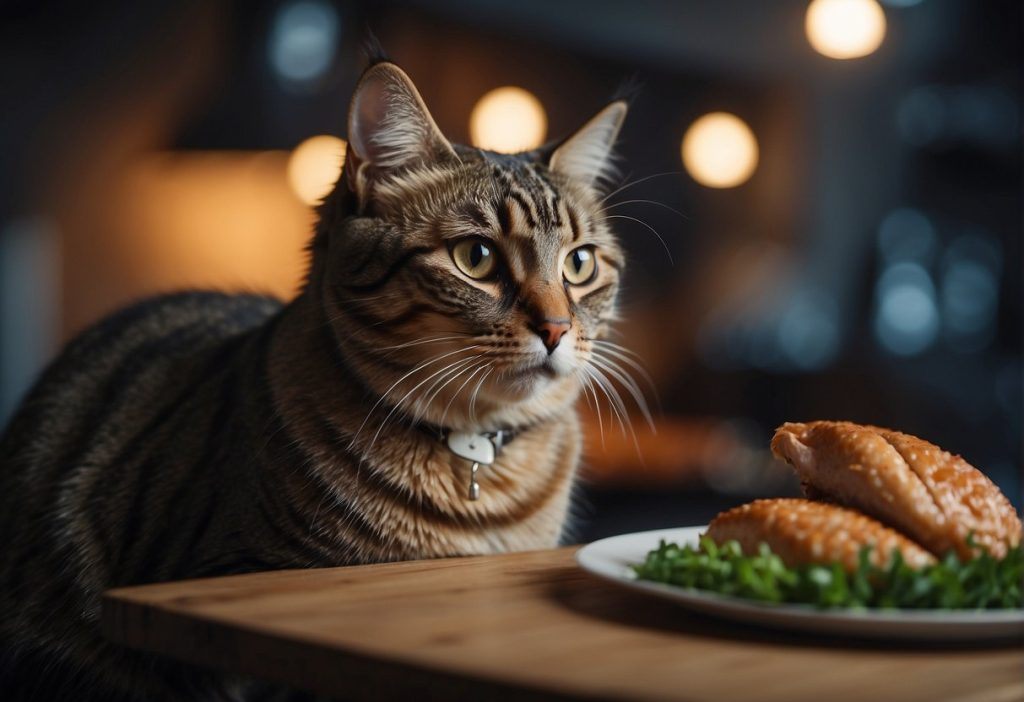
Got questions about feeding your fur baby raw chicken? Let’s scratch the surface and claw into some common concerns cat parents like you have about this meaty topic.
Can I feed my cat raw chicken if it has a medical condition?
If your kitty has any health issues, it’s always best to consult with your vet before introducing raw chicken into their diet.
Some conditions might require a specific feeding regimen that raw chicken won’t fit into.
How often is it safe to treat my kitty to a raw chicken feast?
Treating your cat to raw chicken should be done sparingly and not replace a nutritionally balanced diet.
Think of it as an occasional treat, and always in small, manageable portions.
Should I be concerned about the risks of bones in my cat’s raw chicken meal?
Absolutely. Bones can be a choking hazard and might cause intestinal blockages or damage. Always remove bones from raw chicken before serving it to your kitty.
Could serving my feline friend raw chicken lead to worm issues?
Feeding raw chicken can increase the risk of your cat acquiring parasites like tapeworms.
Proper handling and sourcing of the chicken, along with regular parasite control, are crucial.
Apart from chicken, what other raw meats are considered safe for my cat’s consumption?
While cats can eat other raw meats such as beef or fish, it’s important to provide variety and balance. Always ensure the meat is fresh and from a reliable source.
Are there any signs that my cat isn’t tolerating raw chicken well?
Watch for signs of gastrointestinal upset such as vomiting or diarrhea.
If your cat shows negative reactions to raw chicken, it’s best to stop feeding it and consult your vet.
Can I mix raw chicken with dry cat food?
Mixing raw chicken with dry food is not recommended due to the difference in digestion times, which could potentially lead to stomach issues.
If you want to give raw chicken, serve it separately.
- Where to find the most trustworthy real money casinos - August 7, 2025
- Online Casinos That Approve PayPal: The Ultimate Overview - August 7, 2025

